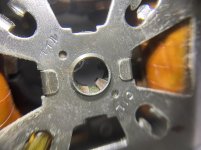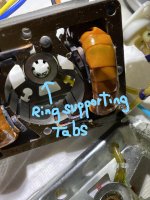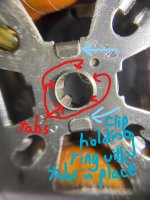Something light; 3in1 or sewing machine oil.
None of that 3 in 1 oil!, it's not a good choice.
Once the sintered bearings are thoroughly flushed of all the old oil, I'd use Zoom Spout Turbine Oil and saturate the bearings with it.
Also, the lower thrust plate is inspected, cleaned, if possible reversed to a new fresh side, because it's likely scored anyway.
Motor shaft should be cleaned and polished too. 1500 or 2000 emery paper.
Then upon re-assembly, while running, the motor gets a few smart taps to center the bearings for minimal friction.
The video shows no "rocking" upon power-down, so I say it needs service.
Those Pioneer and Sanyo syncho motors are finicky things.
Okay, I cleaned and oiled the spindle. The thrust pad looked fine, but I cleaned out the old oil, wiped with IPA and reassembled. Problem persists. I tried moving motor up and down to see if the springs were sagging. No improvement. I have managed to get the motor off the motor plate but cannot get it open. Can I still do the boiling routine without disassembling the motor. Could someone give me a few tips on how best to clean old oil out of the motor and apply new oil?
Thank you.
Jazzzman
Thank you.
Jazzzman
Thanks, I guess I should have been more precise with my question.
Can you use your technique without disassembling the motor? You spoke of using a soldering iron. Would 275 to 300 degrees F be the right temperature? Am I correct that one would keep the tip of the iron near the bearings at the top and bottom of the rotating axis?
You say use a solvent, would alcohol work; would you only use the solvent after the motor cooled to prevent boiling the alcohol or enflaming it? Can you safely pour the solvent into the motor or do you apply it with a swab?
Those are really the questions I meant to ask.
Thank you for your help. I really would like to fix this thing. It is very a nice turntable.
Can you use your technique without disassembling the motor? You spoke of using a soldering iron. Would 275 to 300 degrees F be the right temperature? Am I correct that one would keep the tip of the iron near the bearings at the top and bottom of the rotating axis?
You say use a solvent, would alcohol work; would you only use the solvent after the motor cooled to prevent boiling the alcohol or enflaming it? Can you safely pour the solvent into the motor or do you apply it with a swab?
Those are really the questions I meant to ask.
Thank you for your help. I really would like to fix this thing. It is very a nice turntable.
CRC Electronic Cleaner is a non flammable solvent.
The bearings, including their end mounts, are to be removed for flushing.
A 30W soldering pencil is inserted into the shaft hole of bearing, kept there till old oil bubbles out, remove iron and immediately sprayed with CRC.
Done several times until all oil residue is flushed.
Last heating, bearing is dunked or saturated in Zoom Spout Turbine Oil - the oil is drawn into bearing pores as the bearing cools.
Excess oil is wiped.
Motor re-assembled, tapped with a mallet to center bearings.
add another drop to bearings.
Shaft should rock back and forth when it comes to a stop when spun.
I can't make it any clearer.
The bearings, including their end mounts, are to be removed for flushing.
A 30W soldering pencil is inserted into the shaft hole of bearing, kept there till old oil bubbles out, remove iron and immediately sprayed with CRC.
Done several times until all oil residue is flushed.
Last heating, bearing is dunked or saturated in Zoom Spout Turbine Oil - the oil is drawn into bearing pores as the bearing cools.
Excess oil is wiped.
Motor re-assembled, tapped with a mallet to center bearings.
add another drop to bearings.
Shaft should rock back and forth when it comes to a stop when spun.
I can't make it any clearer.
Last edited:
If you can't get that oil, get liquid WD40, or 5W30 engine oil.
Or front fork oil for motorcycles.
And where I can, in SMPS fans for example, I put a little - match head or two - of front axle grease, which is a higher quality grease than regular grease, as it has a higher temperature rating, and does not dry out as quickly as normal grease. I add this to an oiled spindle. The bearings are mostly sintered, which means they soak oil in the pores.
Another thing I have stated doing is varnishing the PCB on SMPS, less chance of flashover caused by a combination of dust and humidity. Insurance of sorts.
Or front fork oil for motorcycles.
And where I can, in SMPS fans for example, I put a little - match head or two - of front axle grease, which is a higher quality grease than regular grease, as it has a higher temperature rating, and does not dry out as quickly as normal grease. I add this to an oiled spindle. The bearings are mostly sintered, which means they soak oil in the pores.
Another thing I have stated doing is varnishing the PCB on SMPS, less chance of flashover caused by a combination of dust and humidity. Insurance of sorts.
If you can't get that oil, get liquid WD40, or 5W30 engine oil.
Or front fork oil for motorcycles.
And where I can, in SMPS fans for example, I put a little - match head or two - of front axle grease, which is a higher quality grease than regular grease, as it has a higher temperature rating, and does not dry out as quickly as normal grease. I add this to an oiled spindle. The bearings are mostly sintered, which means they soak oil in the pores.
Another thing I have stated doing is varnishing the PCB on SMPS, less chance of flashover caused by a combination of dust and humidity. Insurance of sorts.
After decades of servicing turntables and tape decks, I've distanced myself from all the old pretrol style lubes.
WD40 crap and engine oil should never be used with small motors.
As for grease, Super Lube is a much better choice for lubrication of sliding surfaces and slow-moving platter ball bearings.
I was finally able to disassemble the motor, but I may have put my foot in it, so to speak. First, I started to clean out the bearing at the bottom of the shaft, using my soldering iron. Then I started to clean out the bearing at the top of the shaft. While trying to push a swab into the center, the bearing popped out. See photos attached. I do not know which way to orient it (it has a lip on one end) and I cannot figure out how to push it back in. There are little tabs that it rotates on that clearly suggest I have to push it in from the top (shown in photo 3, but it does not appear to fit through that hole. Photo 4 shows the spot for the bearing as seen from the bottom (inside) of the motor.
Any thoughts on how I can save this?
Thank you,
Jazzzman
Any thoughts on how I can save this?
Thank you,
Jazzzman
Attachments
The tabs seem to act as a spring lock
I would smear a liitle oil on the outside and push it in.
On the other hand, an excellent chance to lube the bearing properly has come.
It is really a sintered bush.... clean it, then let the solvent dry off.
Then soak in lube for 24 hours at least, that means submerged.
Then fit it.
This will give you a very long lube life.
And think of converting your LPs to digital, these are going scarce.
I would smear a liitle oil on the outside and push it in.
On the other hand, an excellent chance to lube the bearing properly has come.
It is really a sintered bush.... clean it, then let the solvent dry off.
Then soak in lube for 24 hours at least, that means submerged.
Then fit it.
This will give you a very long lube life.
And think of converting your LPs to digital, these are going scarce.
Super Lube is synthetic silicon grease with teflon added.
Here generically called plastic grease.
In our climate the teflon added greases are sometimes not stable.
So I use front axle grease on metal, and silicon grease on plastic parts.
Silicon spray can be used in clock movements.
A slight smear is enough in slow speed equipment.
Here generically called plastic grease.
In our climate the teflon added greases are sometimes not stable.
So I use front axle grease on metal, and silicon grease on plastic parts.
Silicon spray can be used in clock movements.
A slight smear is enough in slow speed equipment.
Throw in the towel?
Well, I think I managed to clean the bottom bearing. But I cannot get the top bearing (bushing?) back into place. It is too large in diameter to fit through the top and underneath where there is enough room, there are tabs that the bearing (or bushing?) sits on when in place that do not allow it to pass. I was trying to remove the tabs by prying open the clips that are holding them in place, but I cannot get them to budge. Does anyone know of any way to get that bearing (bushing?) back in?
Thanks for any help anyone can give.
Wiseoldtech, you mentioned removing the bearings, how do you get them back in?
Well, I think I managed to clean the bottom bearing. But I cannot get the top bearing (bushing?) back into place. It is too large in diameter to fit through the top and underneath where there is enough room, there are tabs that the bearing (or bushing?) sits on when in place that do not allow it to pass. I was trying to remove the tabs by prying open the clips that are holding them in place, but I cannot get them to budge. Does anyone know of any way to get that bearing (bushing?) back in?
Thanks for any help anyone can give.
Wiseoldtech, you mentioned removing the bearings, how do you get them back in?
Attachments
It looks like you will have to remove the supporting ring that supports the tabs.
Use a little WD40 or something to loosen up the ring a day or so before going in.
You will have to pry open the tabs, put the bush in place, and put the tabs back, tightening the support ring fron top by gently using a tiny vise or a soft hammer after the shaft is in place.
The tabs may be soft or brittle, and the whole thing has not been disturbed for decades. Be utterly careful.
But how did the bush come out?
You were doing something and it just came out?
Use a little WD40 or something to loosen up the ring a day or so before going in.
You will have to pry open the tabs, put the bush in place, and put the tabs back, tightening the support ring fron top by gently using a tiny vise or a soft hammer after the shaft is in place.
The tabs may be soft or brittle, and the whole thing has not been disturbed for decades. Be utterly careful.
But how did the bush come out?
You were doing something and it just came out?
Well, I think I managed to clean the bottom bearing. But I cannot get the top bearing (bushing?) back into place. It is too large in diameter to fit through the top and underneath where there is enough room, there are tabs that the bearing (or bushing?) sits on when in place that do not allow it to pass. I was trying to remove the tabs by prying open the clips that are holding them in place, but I cannot get them to budge. Does anyone know of any way to get that bearing (bushing?) back in?
Thanks for any help anyone can give.
Wiseoldtech, you mentioned removing the bearings, how do you get them back in?
I'm sorry that you took it to mean removing the bearings from the end housings.
I did not imply or suggest to do that.
Because of that, you now have another mess on your hands.
Cooking the bearings to cause the old oil out was to be done while they are IN the end housings - as I've always done it.
I keep things simple, I don't need the extra work that you now have to enjoy.
I was trying to clean it with a solvent soaked swab and it popped out. I must have been pushing down on it from above. I should have tried from below.
It occurred to me that I might be able to use an index card rolled into a funnel to hold the tabs out (they are very flexible) and slide the bearing into place from below. I will let you know if it works.
It occurred to me that I might be able to use an index card rolled into a funnel to hold the tabs out (they are very flexible) and slide the bearing into place from below. I will let you know if it works.
- Home
- Source & Line
- Analogue Source
- cap for motor in Pioneer PL-50 turntable




![IMG_6026[5226].jpg](/community/data/attachments/811/811007-35405b2df51a58dee56c7b6147705b3c.jpg?hash=NUBbLfUaWN)

